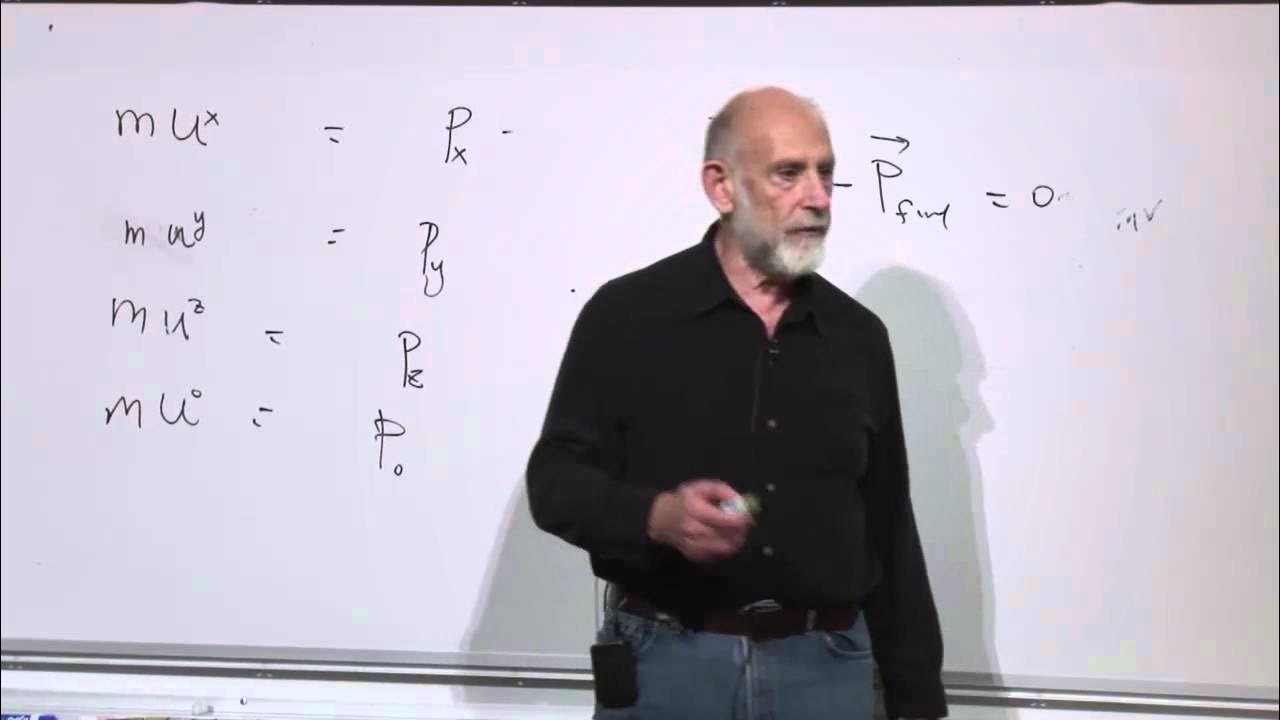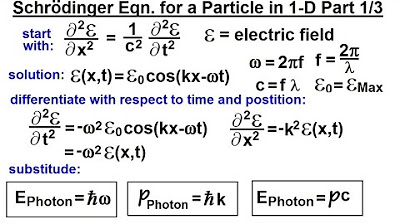How can a photon have momentum?
TLDRThis video script delves into the complex question of how photons, which lack mass, possess momentum. It begins by introducing the classical physics equations for momentum and kinetic energy, then challenges their applicability to massless particles like photons. The script explores Einstein's famous equation, E=mc^2, and its limitations, leading to a more general equation that encompasses all scenarios, including massless objects. It concludes by suggesting that mass is an illusion and that all objects, including photons, are essentially moving energy, thus possessing momentum.
Takeaways
- 💡 Physics enthusiasts often question how photons, which have no mass, can have momentum.
- 🔢 The common equation for momentum, p = mv, does not apply to photons since their mass (m) is zero.
- ⚛️ Kinetic energy (KE) and momentum are related, but the classical equations only work for objects with mass moving at slow speeds.
- 📐 A more general equation, E² = (pc)² + (mc²)², works for all objects, including massless photons.
- 🔍 For photons, since their mass is zero, the equation simplifies to E = pc, showing that energy and momentum are directly related.
- 🧠 Understanding when and how different physics equations apply is crucial to avoid confusion.
- 🌀 Modern physics shows that mass is essentially an illusion, with objects like protons and neutrons being vortices of motion and energy.
- 🌌 Both photons and protons are essentially moving energy, explaining why both can have momentum.
- 📚 Equations like E = mc² are approximations that only work in specific scenarios, such as stationary objects with mass.
- 🔭 The study of physics reveals deep and complex connections between energy, mass, and momentum, highlighting the intricate nature of the subatomic world.
Q & A
Why do people question the existence of momentum in a photon, which has no mass?
-People question this because they learn in physics that momentum (p) is mass (m) times velocity (v), and since a photon has no mass, it should have zero momentum according to the formula p = m * v.
What is the relationship between kinetic energy and momentum in classical physics?
-In classical physics, kinetic energy (KE) is related to momentum (p) by the equation KE = p^2 / (2 * m), showing that anything with kinetic energy must also have momentum.
Why do the classical equations for momentum and kinetic energy not apply to photons?
-The classical equations are special cases that only apply to objects with mass moving at slow speeds. Photons, being massless and moving at the speed of light, require a more general equation.
What is the general equation that relates energy, momentum, and mass for all objects, including photons?
-The general equation is E^2 = (p * c)^2 + (m * c)^2, where E is energy, p is momentum, c is the speed of light, and m is mass. This equation works for all situations, including massless objects like photons.
How does the general equation show that a photon has momentum?
-For a photon with zero mass, the equation simplifies to E = p * c, indicating that energy and momentum are directly proportional, and thus a photon, which has energy, must have momentum.
What is the significance of Einstein's famous equation E = mc^2 in the context of photons?
-Einstein's equation E = mc^2 is an approximation that only works for stationary objects with mass. It does not apply to massless objects like photons or objects moving at speeds close to the speed of light.
Why is it important to understand the limitations of physical equations?
-Understanding the limitations of equations is crucial because using them in inappropriate situations can lead to confusion and incorrect conclusions about physical phenomena.
What does the script suggest about the concept of mass in modern physics?
-The script suggests that mass is an illusion in modern physics, implying that what we perceive as mass is actually a form of energy, especially in the context of subatomic particles.
How does the script explain the mass of protons and neutrons?
-The script explains that the mass of protons and neutrons comes from the energy of the particles orbiting each other at high speeds, suggesting that mass is essentially a form of energy.
What is the script's final message about the study of physics?
-The script's final message is that as one studies physics more deeply, there is always more to appreciate, and the more one appreciates, the more one realizes that physics encompasses everything.
How does the script encourage viewers to further explore the topic of mass and energy?
-The script encourages viewers to watch another video provided in the description, which delves into the idea that mass is an illusion and offers a more detailed explanation of the relationship between mass and energy.
Outlines
🧠 Photon Momentum Mystery
This paragraph introduces the perplexing question of how a massless photon can possess momentum. It acknowledges the viewers' intelligence and curiosity, setting the stage for a complex exploration. The script apologizes for the heavy use of math, which is necessary to explain the concept of momentum in relation to the equation 'p = mv'. It highlights the apparent contradiction that a photon, traveling at the speed of light, should have zero momentum due to its lack of mass. The video promises to delve into equations and then offer a more intuitive explanation, preparing viewers for a challenging but enlightening discussion.
🔍 Unraveling the Photon's Momentum
The second paragraph delves into the relationship between momentum, mass, and kinetic energy, using the equations 'KE = 1/2 mv^2' and 'p = mv'. It demonstrates the connection between kinetic energy and momentum through mathematical manipulation, leading to 'KE = p^2/2m'. The script then challenges the classical understanding by introducing the limitations of these equations, which only apply to objects with mass moving at slow speeds. It teases the involvement of Einstein's theories and hints at a more general equation that encompasses all scenarios, including massless objects like photons. The paragraph concludes with the revelation of the general equation 'E^2 = p^2c^2 + m^2c^4', which is applicable to all objects, regardless of their state of motion or mass, and specifically shows how it applies to photons, where mass is zero.
🌟 The Essence of Mass and Energy
The final paragraph wraps up the video with a call to action for viewers to engage with the content and a reflection on the broader implications of understanding photon momentum. It emphasizes the importance of applying equations correctly and understanding their limitations. The script suggests that as one delves deeper into physics, the interconnectedness of concepts becomes more apparent, reinforcing the idea that 'physics is everything'. It also hints at a deeper, more intuitive understanding of mass as an illusion, with a link to a related video for further exploration. The paragraph concludes by encouraging viewers to appreciate the complexity and wonder of the subatomic world, leaving them with a sense of awe and curiosity.
Mindmap
Keywords
💡Photon
💡Momentum
💡Mass
💡Speed of Light
💡Kinetic Energy
💡Einstein's Equation
💡Relativistic Energy
💡Special Relativity
💡Classical Physics
💡Subatomic Particles
💡Energy
Highlights
Photons, despite having no mass, possess momentum, a concept that may seem counterintuitive based on the classical momentum equation p = mv.
The classical momentum equation p = mv is not applicable for massless particles like photons, which travel at the speed of light.
Kinetic energy and momentum are related classically, as shown by the equation KE = p^2 / (2m), indicating that anything with kinetic energy must also have momentum.
The limitations of the equation E = mc^2 are discussed, clarifying that it only applies to stationary objects with mass.
A more general equation E^2 = (pc)^2 + (mc^2)^2 is introduced, which is applicable to all objects, including massless ones like photons.
For a photon with zero mass, the energy-momentum relationship simplifies to E = pc, showing that energy and momentum are directly proportional.
The importance of understanding the context and limitations of physical equations is emphasized to avoid confusion.
The concept that mass is an illusion in modern physics is introduced, suggesting that mass is essentially energy.
Protons and neutrons are described as vortices of motion and energy, with their mass originating from the energy of their internal motion.
The idea that moving mass is essentially moving energy is presented, drawing a parallel between the momentum of a moving photon and a moving proton.
The video encourages viewers to delve deeper into physics to appreciate its complexity and the interconnectedness of mass and energy.
The video concludes by highlighting the importance of using physical equations correctly within their intended contexts.
The transcript provides a link to further explore the limitations of the E = mc^2 equation in different scenarios.
A link to a video explaining the concept that mass is an illusion and essentially energy is provided for interested viewers.
The video's outro music signifies the end of the exploration into the complex topic of photon momentum.
Transcripts
Browse More Related Video

Why light has energy, but no mass? (Understanding E = mc2)

Special Relativity | Lecture 3

Why speed of light results in E = mc^2 ? [Einstein's original proof]

Deriving Einstein's most famous equation: Why does energy = mass x speed of light squared?

Why does E=MC²?

Physics - Ch 66 Ch 4 Quantum Mechanics: Schrodinger Eqn (5 of 92) The Schrodinger Eqn. in 1-D (1/3)
5.0 / 5 (0 votes)
Thanks for rating: